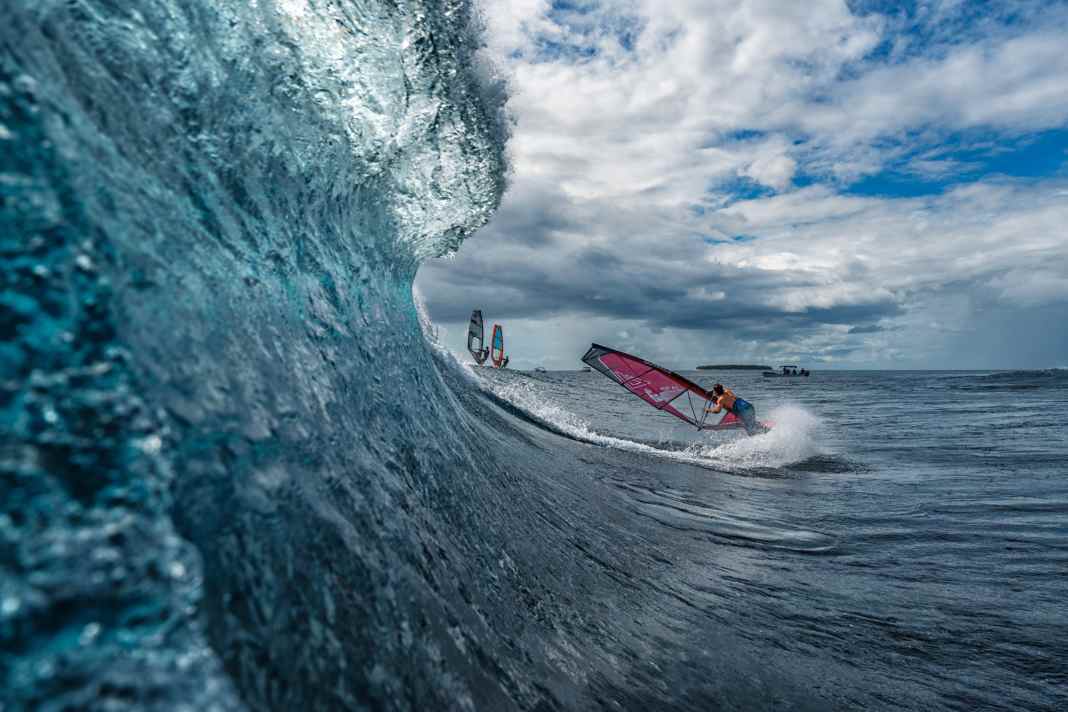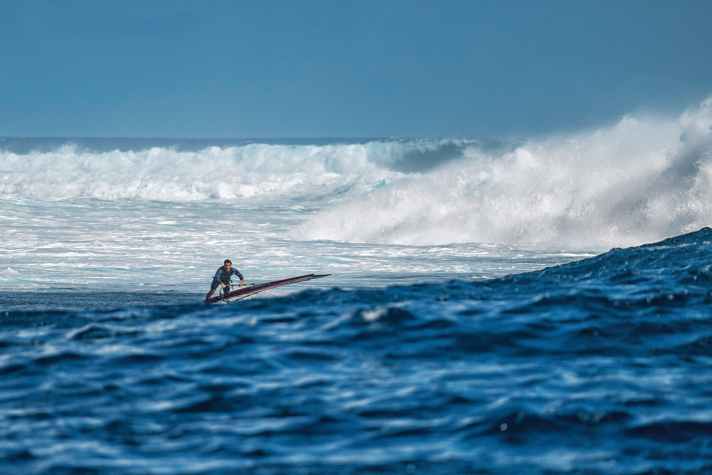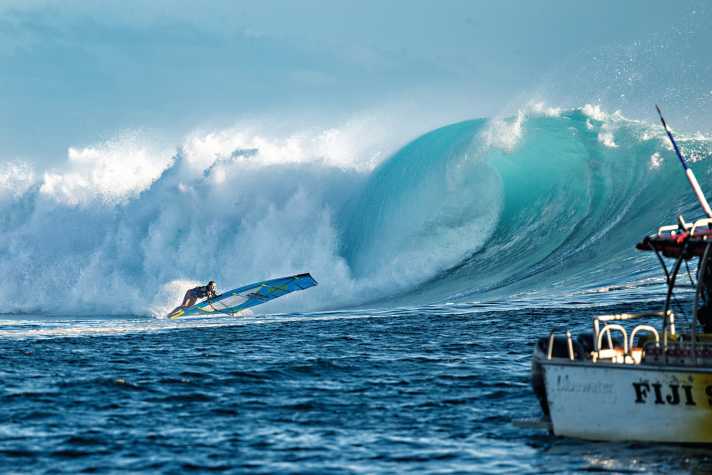





Has a professional windsurfing competition ever seemed closer to perfection than the Namotu Wave Classic, as documented on the legendary 1997 VHS tape? A bunch of sun-drenched guys are set adrift on a deserted island in the Pacific Ocean to compete against each other in tropical water temperatures, constant gliding winds and mast-high waves.
I don't remember who won, but the atmospheric images of paradisiacal beaches, accompanied by the guitar sounds of the nineties, the charismatic characters with their audacious dialects: All of this is not only etched in my memory forever, but also in that of an entire windsurfing generation - especially Josh Stone's legendary aerial, in which he hovers for what feels like an eternity over the hollow-breaking wave, as if he were flirting with the Melanesian gods high above the clouds.
Cloudbreak - A windsurfing dream comes true
A quarter of a century after the Namotu Wave Classic, Fiji Kurukuru is on the calendar of the Unified Wave Tour, providing the long-awaited alternative to the well-known Pozo-Tenerife-Sylt format.
After Japan, this is the second five-star competition - which means that the points count one hundred per cent towards the annual ranking. Even though only the best four results are counted at the end of the year, a future world champion can hardly afford to slip up at one of the five-star competitions. In addition to Japan and Fiji, Gran Canaria, Sylt and Maui count for one hundred per cent. The four-star competitions in Chile and Peru also count for 40 per cent of the score.
When a forecast for constant wind and consecutive groundswells solidified in the models at the end of May, the expectations of both the riders and many fans for the Fiji Surf Pro organised by the IWT rose immeasurably.
A hell of a ride over the razor-sharp reef
Cloudbreak, which the locals also call Kurukuru, is one of the best spots on earth. It is only a few kilometres away from Namotu and is considered its big brother. The waves break on a reef edge in front of the mainland. When a groundswell pushes through between the Australian and New Zealand coasts, the wave crests hug the rapidly flattening reef edge, build up on the outer peak and throw a barrel that breaks perfectly from left to right and only gains energy in the process. The barrel gets bigger and rounder - the last section resembles a cylinder - before Kurukuru ends in Shish Kebabs, as the infamous last section is called, in a closeout onto the dry reef at low tide. A hell of a ride that is perfect for windsurfing if you have the necessary reflexes.
Normal World Cups cost an entry fee of 200 dollars - in Fiji it's 1200.
The general conditions of the Fiji Surf Pro quickly bring you back to the year 2023 and down to earth. While the entry fee for international competitions is usually around USD 200, the fee for Fiji is USD 1200. This means that part of the event is financed by the riders themselves - despite the fact that travelling expenses already consume a large part or even the entire annual budget for quite a few Europeans. In 1997, it was title sponsor O'Neill who made the dream possible. Nowadays, competition organisers have to deal with sponsors dropping out at short notice time and again. A phenomenon that has unfortunately become more the rule than the exception in windsurfing.

A contest in the middle of the sea
What's more, the competition takes place more or less in the middle of the sea - and is therefore associated with a number of logistical hurdles. The entire crew and riders have to be transported from the mainland to the reef along with their equipment and gear - a journey of around 40 minutes on the locals' longboats. The mother ship of the judges, crew and media teams takes a whole two hours from the mainland. Accommodation on one of the private islands is not even an option.
The Fiji Surf Pro has what it takes to revitalise professional windsurfing in 2023 - but at what cost?
It quickly becomes clear: nobody is here for the money. Whether photographers, filmmakers, commentators, judges or riders and organisers - everyone brings a lot of commitment and ultimately invests so that the event can take place. It's an event that has the potential to cater to the highest level of windsurfing in the waves in a way that probably no other venue can. The Fiji Surf Pro has what it takes to revitalise professional windsurfing in 2023 - but at what cost?
The standby window stretches over eleven days. However, only three days of racing are planned - just enough to run a single elimination with long heat times for the men and women. The fields consist of a refreshing mix of IWT and PWA greats, although unfortunately some top seeds such as Lina Erpenstein, the Moreno sisters, Justyna Sniady, Thomas Traversa and Camille Juban are missing due to injury or for financial or personal reasons.
The top riders retire early
Round 1 starts. One and a half mast-high waves and gliding wind. 28 minutes. No second chance, all or nothing! For Philip Köster, it's all or nothing, or better still: retirement. During the bottom turn, his recently broken foot hurts too much for him to exert the necessary pressure on the board. Victor Fernandez only manages third place against the strong riders Flo Jung and Anthony Ruenes and is thus eliminated early as the second world champion. The biggest surprise, however, was the elimination of reigning world champion Marcilio Browne. One of the few who had already visited Cloudbreak before, but was unable to find a rhythm on this day and felt the full force of Cloudbreak on several occasions. Marc Pare, who also doesn't have a good heat and already thinks he can book his return flight, continues in 1st place together with an overjoyed Federico Morisio.
In pure wave riding events, where no jumps are counted, the judges can assess four riders at the same time. This means that riders are not judged against riders - instead, the best two of four participants in each heat progress.
Baptiste Cloarec with the aerial of the day
The standout on day 1 is certainly the still relatively unknown Baptiste Cloarec, who is one of the few who manages to navigate his board under the lip of the barrel to fly away from there in a radical aireal à la Josh Stone.
After the first day of competition, the wind cancels and things calm down for a few days. Little by little, the euphoria of the start disappears, only for the high expectations of wave perfection to be exceeded. Instead, the participants become more aware of how brutal this format is. One mistimed ride - and the savings sink into the depths of the Pacific along with all hope of valuable ranking points.
One mistimed ride and the savings sink into the depths of the Pacific.
For me, round 1 against Takuma Sugi and Björn Dunkerbeck, who of course was also here in Fiji in 1997 and is now mainly travelling with his son Liam, posed no real threat. And I enjoy the surreal experience of windsurfing with only two other people on the water in Cloudbreak.
In round two, however, the omens have changed. The wind is strong, but the waves have almost disappeared. In 28 minutes I don't manage to find a set wave and am eliminated by Takuma Sugi, who rides rather conservatively but catches the few good waves of the heat, and Antoine Martin, the judges' favourite.
Morgan Noireaux and Bernd Roediger, who I thought were the best riders alongside Baptiste in the previous days, also failed to qualify for the quarter-finals on this grumpy day. The two Hawaiians have long since proven that they can not only win in Hookipa - as long as the waves are good. As a new swell is already on its way for the final day, this is particularly bitter.
The ladies also go all out in Cloudbreak
On the final day, the waves break even more powerfully than on day 1. At last, and unlike in 1997, the women are allowed on the water. Many of the riders now gain their first experience in Cloudbreak in the heat. The Australian Jane Seman, who lives in Margaret River and is therefore experienced in big waves, surprisingly does not qualify for the final. Instead, French rider Coraline Foveau causes a stir with her fearless approach - she rides the wave with a lot of risk, gets washed onto the reef several times, but also manages to collect good scores.
The final is opened by the Queen of Windsurfing, Sarah-Quita Offringa. She grabs one of the biggest waves of the entire event far out and rides it down to the channel with clean, powerful turns - all the boats applaud. Sarah Hauser waits a long time before taking her first wave. It is not as big as Sarah-Quita's, but it is much steeper. Sarah puts her perfectly timed turns on the most powerful part of the waves, only to escape the enormous force of the roaring barrel behind her by a hair's breadth. On her second wave, she surpasses the feat once again - another round of applause and the winner is crowned!

Takuma Sugi, Robby Swift, Ricardo Campello and Baptiste Cloarec make up the men's final line-up. The wind is very light and the waves are breaking as hollow as ever. And once again it is Baptiste Cloarec who is in a different league. With his small stature and perfectly matched equipment, he is able to position himself lower and attack the lip later than everyone else. With plenty of speed and flow, he lines up one air or turn after the next. The Breton is currently studying to become a captain on the Britanny Ferries. The trip was also an investment for him. In his case, it paid off in full, as he flies home as Fiji champion - and even with a plus in his account.
The images from Cloudbreak go around the world
The fantastic pictures by Paul and Sofie from Fishbowl Diaries, by Maleen Hoekstra, by Guillermo Cervera as well as the videos by Jace Panebianco and - above all - the drone shots by Paul van Bellen go around the world. "The best windsurfing action ever seen", is the commentary. An article on a surfing website makes fun of the fact that the World Surf League, pumped full of millions of US dollars, is unable to keep the prestigious Fiji Pro alive. The windsurfers, on the other hand, this sport from the last century, could manage it. A picture of a windsurfer hovering over a mighty barrel. Yes, you can be a little proud.
Mission accomplished?! The majority of the riders fly home with mixed feelings, although hardly anyone regrets having come. The Unified Wave Tour has a long way to go, it is now time to think ahead and face the realities of today, far removed from the romanticised nineties. A reasonable entry fee and more competition days that allow for a fair format (be it a single, double or single elimination) are the prerequisites for me to once again make the long journey around the world to experience the miracle of Kurukuru.

